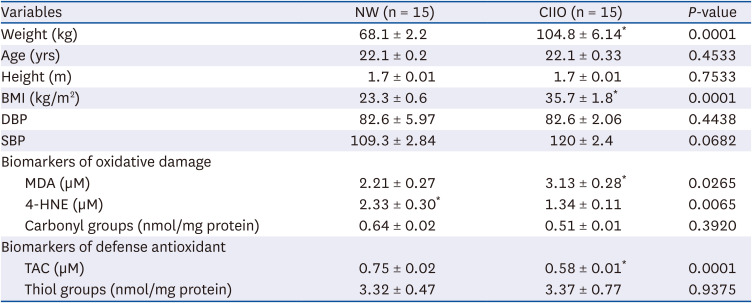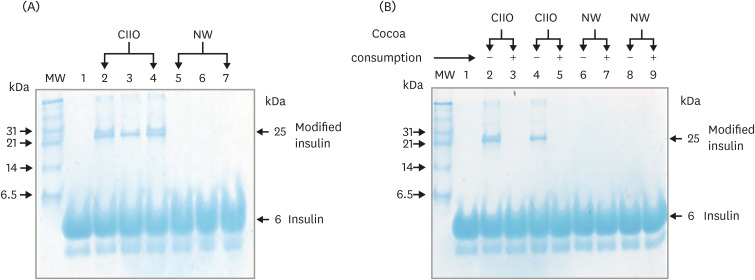1. Afshin A, Forouzanfar MH, Reitsma MB, Sur P, Estep K, Lee A, Marczak L, Mokdad AH, Moradi-Lakeh M, Naghavi M, et al. Health effects of overweight and obesity in 195 countries over 25 years. N Engl J Med. 2017; 377:13–27. PMID:
28604169.
2. Apovian CM. Obesity: definition, comorbidities, causes, and burden. Am J Manag Care. 2016; 22(Suppl):s176–s185. PMID:
27356115.
3. Czech MP. Insulin action and resistance in obesity and type 2 diabetes. Nat Med. 2017; 23:804–814. PMID:
28697184.
4. Xue W, Fan Z, Li L, Lu J, Zhai Y, Zhao J. The chemokine system and its role in obesity. J Cell Physiol. 2019; 234:3336–3346. PMID:
30375006.
5. Montes-Cortes DH, Hicks JJ, Ceballos-Reyes GM, Garcia-Sanchez JR, Medina-Navarro R, Olivares-Corichi IM. Chemical and functional changes of human insulin by in vitro incubation with blood from diabetic patients in oxidative stress. Metabolism. 2010; 59:935–942. PMID:
20022071.
6. Olivares-Corichi I, Rincon Viquez M, Gutierrez-Lopez L, Ceballos-Reyes G, Garcia-Sanchez J. Oxidative stress present in the blood from obese patients modifies the structure and function of insulin. Horm Metab Res. 2011; 43:748–753. PMID:
22009368.
7. Rincón Víquez MJ, García-Sánchez JR, Tapia González MA, Gutiérrez López L, Ceballos-Reyes GM, Olivares-Corichi IM. Insulin polymers in the plasma of obese subjects are associated with elevated levels of carbonyl groups and are decreased by (-)-epicatechin. Horm Metab Res. 2014; 46:499–504. PMID:
24810472.
8. Xing J, Chen C. Hyperinsulinemia: beneficial or harmful or both on glucose homeostasis. Am J Physiol Endocrinol Metab. 2022; 323:E2–E7. PMID:
35635329.
9. Klop B, Elte JW, Cabezas MC. Dyslipidemia in obesity: mechanisms and potential targets. Nutrients. 2013; 5:1218–1240. PMID:
23584084.
12. Macena ML, Nunes LF, da Silva AF, Pureza IR, Praxedes DR, Santos JC, Bueno NB. Effects of dietary polyphenols in the glycemic, renal, inflammatory, and oxidative stress biomarkers in diabetic nephropathy: a systematic review with meta-analysis of randomized controlled trials. Nutr Rev. Forthcoming. 2022.
13. Ren N, Kim E, Li B, Pan H, Tong T, Yang CS, Tu Y. Flavonoids Alleviating Insulin Resistance through Inhibition of Inflammatory Signaling. J Agric Food Chem. 2019; 67:5361–5373. PMID:
30612424.
14. Aprotosoaie AC, Miron A, Trifan A, Luca VS, Costache II. The cardiovascular effects of cocoa polyphenols-an overview. Diseases. 2016; 4:39. PMID:
28933419.
15. Koch W. Dietary polyphenols-important non-nutrients in the prevention of chronic noncommunicable diseases. A systematic review. Nutrients. 2019; 11:1039. PMID:
31075905.
16. Martín MA, Ramos S. Cocoa polyphenols in oxidative stress: potential health implications. J Funct Foods. 2016; 27:570–588.
17. Crozier SJ, Preston AG, Hurst JW, Payne MJ, Mann J, Hainly L, Miller DL. Cacao seeds are a “Super Fruit”: a comparative analysis of various fruit powders and products. Chem Cent J. 2011; 5:5. PMID:
21299842.
18. González-Garrido JA, García-Sánchez JR, Garrido-Llanos S, Olivares-Corichi IM. An association of cocoa consumption with improved physical fitness and decreased muscle damage and oxidative stress in athletes. J Sports Med Phys Fitness. 2017; 57:441–447. PMID:
26632851.
19. Hernández-Alcaraz C, Aguilar-Salinas CA, Mendoza-Herrera K, Pedroza-Tobías A, Villalpando S, Shamah-Levy T, Rivera-Dommarco J, Hernández-Ávila M, Barquera S. Dyslipidemia prevalence, awareness, treatment and control in Mexico: results of the Ensanut 2012. Salud Publica Mex. 2020; 62:137–146. PMID:
32237556.
20. Murguía-Romero M, Jiménez-Flores JR, Sigrist-Flores SC, Tapia-Pancardo DC, Jiménez-Ramos A, Méndez-Cruz AR, Villalobos-Molina R. Prevalence of metabolic syndrome in young mexicans: a sensitivity analysis on its components. NCtr Hosp. 2015; 32:189–195.
21. Obesity: preventing and managing the global epidemic. Report of a WHO consultation. World Health Organ Tech Rep Ser. 2000; 894:i–ixii. 1–253. PMID:
11234459.
22. Grassi D, Desideri G, Necozione S, di Giosia P, Barnabei R, Allegaert L, Bernaert H, Ferri C. Cocoa consumption dose-dependently improves flow-mediated dilation and arterial stiffness decreasing blood pressure in healthy individuals. J Hypertens. 2015; 33:294–303. PMID:
25380152.
23. Somerville V, Bringans C, Braakhuis A. Polyphenols and performance: a systematic review and meta-analysis. Sports Med. 2017; 47:1589–1599. PMID:
28097488.
24. Basu A, Betts NM, Leyva MJ, Fu D, Aston CE, Lyons TJ. Acute cocoa supplementation increases postprandial HDL cholesterol and insulin in obese adults with type 2 diabetes after consumption of a high-fat breakfast. J Nutr. 2015; 145:2325–2332. PMID:
26338890.
25. Matthews DR, Hosker JP, Rudenski AS, Naylor BA, Treacher DF, Turner RC. Homeostasis model assessment: insulin resistance and beta-cell function from fasting plasma glucose and insulin concentrations in man. Diabetologia. 1985; 28:412–419. PMID:
3899825.
26. Gérard-Monnier D, Erdelmeier I, Régnard K, Moze-Henry N, Yadan JC, Chaudière J. Reactions of 1-methyl-2-phenylindole with malondialdehyde and 4-hydroxyalkenals. Analytical applications to a colorimetric assay of lipid peroxidation. Chem Res Toxicol. 1998; 11:1176–1183. PMID:
9778314.
27. Reznick AZ, Packer L. Oxidative damage to proteins: spectrophotometric method for carbonyl assay. Methods Enzymol. 1994; 233:357–363. PMID:
8015470.
28. Lowry OH, Rosebrough NJ, Farr AL, Randall RJ. Protein measurement with the Folin phenol reagent. J Biol Chem. 1951; 193:265–275. PMID:
14907713.
29. Ellman GL. Tissue sulfhydryl groups. Arch Biochem Biophys. 1959; 82:70–77. PMID:
13650640.
30. Gutierrez-Lopez L, Garcia-Sanchez JR, Rincon-Viquez MJ, Lara-Padilla E, Sierra-Vargas MP, Olivares-Corichi IM. Hypocaloric diet and regular moderate aerobic exercise is an effective strategy to reduce anthropometric parameters and oxidative stress in obese patients. Obes Facts. 2012; 5:12–22. PMID:
22433613.
31. Aprotosoaie AC, Luca SV, Miron A. Flavor chemistry of cocoa and cocoa products: an overview. Compr Rev Food Sci Food Saf. 2016; 15:73–91. PMID:
33371573.
32. Khan N, Khymenets O, Urpí-Sardà M, Tulipani S, Garcia-Aloy M, Monagas M, Mora-Cubillos X, Llorach R, Andres-Lacueva C. Cocoa polyphenols and inflammatory markers of cardiovascular disease. Nutrients. 2014; 6:844–880. PMID:
24566441.
33. Esser D, Mars M, Oosterink E, Stalmach A, Müller M, Afman LA. Dark chocolate consumption improves leukocyte adhesion factors and vascular function in overweight men. FASEB J. 2014; 28:1464–1473. PMID:
24302679.
34. Di Renzo L, Rizzo M, Sarlo F, Colica C, Iacopino L, Domino E, Sergi D, De Lorenzo A. Effects of dark chocolate in a population of normal weight obese women: a pilot study. Eur Rev Med Pharmacol Sci. 2013; 17:2257–2266. PMID:
23893195.
35. Pereyra-Vergara F, Olivares-Corichi IM, Perez-Ruiz AG, Luna-Arias JP, García-Sánchez JR. Apoptosis induced by (-)-epicatechin in human breast cancer cells is mediated by reactive oxygen species. Molecules. 2020; 25:1020. PMID:
32106523.
36. Mehrabani S, Arab A, Mohammadi H, Amani R. The effect of cocoa consumption on markers of oxidative stress: a systematic review and meta-analysis of interventional studies. Complement Ther Med. 2020; 48:102240. PMID:
31987247.
37. Grassi D, Desideri G, Necozione S, Lippi C, Casale R, Properzi G, Blumberg JB, Ferri C. Blood pressure is reduced and insulin sensitivity increased in glucose-intolerant, hypertensive subjects after 15 days of consuming high-polyphenol dark chocolate. J Nutr. 2008; 138:1671–1676. PMID:
18716168.
38. Leyva-Soto A, Chavez-Santoscoy RA, Lara-Jacobo LR, Chavez-Santoscoy AV, Gonzalez-Cobian LN. Daily consumption of chocolate rich in flavonoids decreases cellular genotoxicity and improves biochemical parameters of lipid and glucose metabolism. Molecules. 2018; 23:2220. PMID:
30200398.
39. Tokede OA, Gaziano JM, Djoussé L. Effects of cocoa products/dark chocolate on serum lipids: a meta-analysis. Eur J Clin Nutr. 2011; 65:879–886. PMID:
21559039.
40. Pal S, Ho N, Santos C, Dubois P, Mamo J, Croft K, Allister E. Red wine polyphenolics increase LDL receptor expression and activity and suppress the secretion of ApoB100 from human HepG2 cells. J Nutr. 2003; 133:700–706. PMID:
12612140.
41. Shimizu M, Li J, Inoue J, Sato R. Quercetin represses apolipoprotein B expression by inhibiting the transcriptional activity of C/EBPβ. PLoS One. 2015; 10:e0121784. PMID:
25875015.
42. Koo SI, Noh SK. Green tea as inhibitor of the intestinal absorption of lipids: potential mechanism for its lipid-lowering effect. J Nutr Biochem. 2007; 18:179–183. PMID:
17296491.
43. Robertson RP. Antioxidant drugs for treating beta-cell oxidative stress in type 2 diabetes: glucose-centric versus insulin-centric therapy. Discov Med. 2010; 9:132–137. PMID:
20193639.
44. Hasnain SZ, Prins JB, McGuckin MA. Oxidative and endoplasmic reticulum stress in β-cell dysfunction in diabetes. J Mol Endocrinol. 2016; 56:R33–R54. PMID:
26576641.
45. Martín MA, Ramos S, Cordero-Herrero I, Bravo L, Goya L. Cocoa phenolic extract protects pancreatic beta cells against oxidative stress. Nutrients. 2013; 5:2955–2968. PMID:
23912326.
46. Fernández-Millán E, Cordero-Herrera I, Ramos S, Escrivá F, Alvarez C, Goya L, Martín MA. Cocoa-rich diet attenuates beta cell mass loss and function in young Zucker diabetic fatty rats by preventing oxidative stress and beta cell apoptosis. Mol Nutr Food Res. 2015; 59:820–824. PMID:
25559866.
47. Martín MA, Fernández-Millán E, Ramos S, Bravo L, Goya L. Cocoa flavonoid epicatechin protects pancreatic beta cell viability and function against oxidative stress. Mol Nutr Food Res. 2014; 58:447–456. PMID:
24115486.
48. Münzel T, Daiber A, Ullrich V, Mülsch A. Vascular consequences of endothelial nitric oxide synthase uncoupling for the activity and expression of the soluble guanylyl cyclase and the cGMP-dependent protein kinase. Arterioscler Thromb Vasc Biol. 2005; 25:1551–1557. PMID:
15879305.
49. Sansbury BE, Hill BG. Regulation of obesity and insulin resistance by nitric oxide. Free Radic Biol Med. 2014; 73:383–399. PMID:
24878261.
50. Caldwell RW, Rodriguez PC, Toque HA, Narayanan SP, Caldwell RB. Arginase: a multifaceted enzyme important in health and disease. Physiol Rev. 2018; 98:641–665. PMID:
29412048.
51. Zhou L, Sun CB, Liu C, Fan Y, Zhu HY, Wu XW, Hu L, Li QP. Upregulation of arginase activity contributes to intracellular ROS production induced by high glucose in H9c2 cells. Int J Clin Exp Pathol. 2015; 8:2728–2736. PMID:
26045778.








 PDF
PDF Citation
Citation Print
Print




 XML Download
XML Download